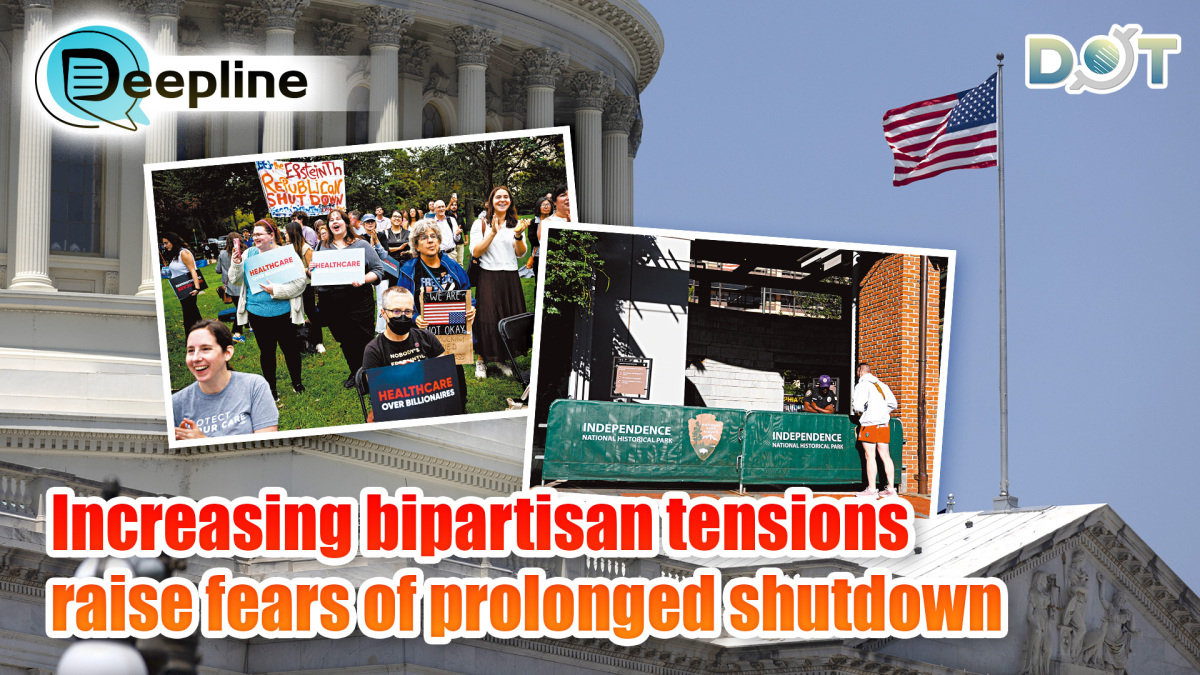
On Oct. 1 local time, a spokesperson for New York Governor Kathy Hochul's office stated that New York State will not cover the operating costs for the Statue of Liberty as it did during the previous government shutdown. The governor mentioned that the torch of the Statue of Liberty might go out completely.
Hochul pointed out that over 100,000 federal workers in New York have been forced to take leave or face the risk of furlough, including dozens working at the Statue of Liberty. It remains unclear whether the statue will close and when such a closure might occur.
During the last government shutdown in 2018, the Statue of Liberty was initially closed, turning away thousands of visitors, but reopened later with funding from the state government.
With the U.S. Congress missing the deadline to reach an agreement on temporary government funding, the federal government officially shut down at midnight Wednesday (Oct. 1 local time), marking the first shutdown since 2019. Before the deadline, the Senate voted on a temporary funding bill to keep the government running until Nov. 21, but it ultimately failed. President Trump threatened to fire hundreds of thousands of non-essential government employees during the shutdown. Analysts warn that the increasing political polarization could lead to significant economic losses, making recovery difficult in the short term.
The Republican-controlled Senate voted on Tuesday on the temporary funding bill, receiving 55 votes in favor and 45 against, falling short of the 60 votes needed to pass. With the government shutdown, the White House budget office has ordered federal agencies to implement contingency plans for funding shortages, limiting operations to essential duties, while many non-essential departments cease operations, forcing up to 750,000 federal employees to take unpaid leave.
Trump Claims Shutdown Could Bring "Many Benefits"
On Tuesday, Trump claimed that the government shutdown could bring "many benefits." He threatened to fire non-essential employees who typically would only take temporary unpaid leave, eliminating certain government programs supported by Democrats, stating, "We can get rid of a lot of things we don't want; those are all Democrat. They don't learn their lesson. So we have no choice but to do this for the country."
According to Reuters, the core of the current budget dispute revolves around US$1.7 trillion allocated for agency operations, which constitutes about a quarter of the U.S. government's total budget of US$7 trillion. The remaining budget primarily funds healthcare and retirement programs, as well as interest payments on at least US$37.5 trillion in debt. Most Democrats are insisting that provisions to extend healthcare benefits under the Affordable Care Act be included in the temporary funding bill, but Republicans have rejected this.
Senate Majority Leader John Thune stated that he plans to continue voting as early as Wednesday, attempting to persuade more Democrats to switch sides and assist Republicans in advancing the funding bill. Minority Leader Chuck Schumer indicated a willingness to negotiate with congressional leaders from both parties and Trump, but emphasized that negotiations must be based on genuine commitment and cooperation from both sides.
Escalating Tensions Make Compromise Harder
Independent analysts in the U.S. are warning that the current deadlock over budget allocations may lead to a longer shutdown than in the past, especially after the assassination of right-wing commentator Kirk intensified political polarization. A professor at the University of Chicago specializing in political violence noted that the extreme factions within both parties are rising, making it difficult for party leaders to compromise and seek consensus. He stated that while prolonged shutdowns are not desirable for either party's leadership, both will likely need to make concessions, despite the challenges involved.
Economic Impact Could Be Severe
While the federal government has experienced multiple short shutdowns in the past, financial analysts suggest that the current shutdown could result in economic losses of up to US$7 billion per week, posing a more severe impact than previous instances. Reports indicate that over 750,000 government employees may be forced into unpaid leave, and Trump's threats to fire them could significantly harm the already fragile job market and increase economic uncertainty.
Experts point out that the tourism industry will be among the first to feel the impact, with many museums, national parks, and monuments closing or reducing hours. The Federal Aviation Administration (FAA) expects to temporarily furlough about 25% of its staff, and several U.S. airlines have warned of potential flight delays during this period.
Key Economic Data Publication Paused
If the federal government remains shut down for an extended period, the economic impacts will gradually become evident. The Department of Labor has indicated that its statistical services will pause the release of key data such as non-farm employment reports during the shutdown, depriving U.S. economic policy of vital inflation indicators. The Federal Reserve will also lack official inflation data, forcing it to rely on private data for policy-making.
A prolonged shutdown will also affect the livelihoods of low- and middle-income groups. Many individuals receiving social security benefits may see disruptions in their living expense adjustments. Millions of pregnant women and children across the country may be forced to delay receiving food stamps, and housing and energy subsidies could be postponed due to federal funding disruptions. Federal assistance for preschool education and school lunches may need to be temporarily covered by local governments, increasing financial pressure on state and county budgets.
The job market is already deteriorating, particularly in Washington, D.C., where many federal employees reside, and has been hit hard by prior layoffs. An economist from NerdWallet noted that the most directly and severely impacted will be the federal employees forced into leave or layoffs. When families lose income, even for just a week, it can destabilize their financial situation.
Analysts from Barclays have indicated that the financial sector initially expected minimal economic impact from the shutdown, but if Trump were to fire all unpaid furloughed employees, it would significantly contradict past norms, adding more uncertainty to the future economic outlook.
Historical Context
Historically, government shutdowns in the U.S. are not uncommon and have occurred during nearly every presidential term since 1980, except for George W. Bush's presidency. Trump previously oversaw the longest shutdown in history, lasting 35 days. The shutdown that began in December 2018 coincided with the second anniversary of Trump's administration and marked the first instance of a government shutdown while one party controlled the White House, Senate, and House of Representatives. This shutdown was not an unforeseen "crisis" but stemmed from long-standing disagreements between Republicans and Democrats over border issues.
During the 2016 campaign, Trump promised to build a wall along the U.S.-Mexico border to prevent illegal immigration. After the Mexican president refused to fund the wall's construction, Trump requested US$5.7 billion in federal funding to renovate aging border fencing in December 2018. This proposal faced strong opposition from Democrats, who deemed the wall ineffective and were willing to provide around US$1.3 billion for border security but not additional funds for a steel barrier. Due to disagreements between the White House and Congress over the border wall, the Senate failed to pass a temporary funding bill that included wall funding, and Trump refused to sign a temporary spending bill that did not include it. As a result, about a quarter of the federal government temporarily ceased operations, affecting approximately 800,000 employees starting in the early hours of Dec. 22.
(Source: CCTV News, Wen Wei Po, Reuters, Xinhua | English Editor: Liu Yu)
Related News:
US govt enters shutdown for first time in nearly 7 years
Shooting and arson at US Mormon church leaves 5 dead, 8 injured: Shooter identified as veteran




















Comment